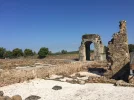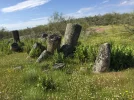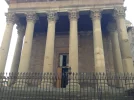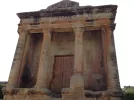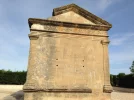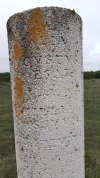- Time of past OR future Camino
- Some in the past; more in the future!
This is the latest thread in the 'architecture for beginners' series begun by @C clearly. Previous threads are on Romanesque, Visigothic/pre-Romanesque and Gothic architecture.
Those three threads mostly focused on a single building type: churches. Roman remains cover many different public and private buildings and that makes this a more complicated topic, but hopefully an enjoyable one to discuss.
To get us started, today I published an article titled Best Roman Sites on the Camino de Santiago. Here's the introduction:
Here are two of these monumental Roman buildings that can be found on the camino.
Roman Theatre at Mérida (VdlP/Mozárabe):

The Roman aqueduct at Segovia (Camino de Madrid):
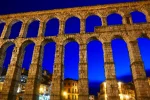
If you're interested in seeing more photos, I have a dedicated Roman Empire album on Flickr.
Some Features of Roman Architecture
Here are just a few features of Roman architecture. There are many more, of course.
Recommended Resources
The History of Rome - a phenomenal podcast by Mike Duncan offering a narrative history of the Roman Empire from the founding of the city of Rome in 753 BC to the traditional end date of the empire in AD 476.
Roman Architecture - an excellent free course by Yale/Coursera that gives an introduction to Roman architecture and architectural techniques and developments.
Following Hadrian - a great project by Carole Raddato following in the footsteps of the Roman emperor Hadrian. She has visited many, many Roman archeological sites and has a vast photo library.
What are the most impressive Roman sites you've seen on the camino? Off the camino? What are the Roman sites you would most like to see? Discuss all things Roman architecture here!
Those three threads mostly focused on a single building type: churches. Roman remains cover many different public and private buildings and that makes this a more complicated topic, but hopefully an enjoyable one to discuss.
To get us started, today I published an article titled Best Roman Sites on the Camino de Santiago. Here's the introduction:
Pilgrims on the Camino de Santiago tread in the very footsteps of the Roman Empire, traversing Roman roads and Roman bridges as they make their way to Santiago de Compostela. Roman milestones and castra (fortified settlements) are also found along the camino and serve as constant reminders of Rome’s expanse and organisational capacity.
These most basic aspects of Roman infrastructure don’t reveal the true grandeur of the empire, however, which is to be found in theatres, amphitheatres, aqueducts, temples and other monumental works of architecture. Fortunately, these more spectacular vestiges of the Roman world are also within reach of pilgrims on the Camino de Santiago.
Here are two of these monumental Roman buildings that can be found on the camino.
Roman Theatre at Mérida (VdlP/Mozárabe):

The Roman aqueduct at Segovia (Camino de Madrid):

If you're interested in seeing more photos, I have a dedicated Roman Empire album on Flickr.
Some Features of Roman Architecture
Here are just a few features of Roman architecture. There are many more, of course.
- Roman temples, such as those seen at Mérida and Córdoba on the camino, show a combination of Greek and Etruscan influences. Typical Roman temples tended to be rectangular with a raised platform, façade orientation and columns all the way around.
- Roman mastery of concrete (which took centuries) was pivotal in allowing for greater structures and larger interior spaces. Examples of this include the concrete dome of the Pantheon in Rome, and the vaulting of Trajan's Market in Rome.
- Arches are a hallmark of Roman architecture, used in aqueducts, amphitheatres and theatres (e.g. the Theatre of Marcellus in Rome). Filled-in arches were also used for weight distribution in buildings like the Pantheon.
Recommended Resources
The History of Rome - a phenomenal podcast by Mike Duncan offering a narrative history of the Roman Empire from the founding of the city of Rome in 753 BC to the traditional end date of the empire in AD 476.
Roman Architecture - an excellent free course by Yale/Coursera that gives an introduction to Roman architecture and architectural techniques and developments.
Following Hadrian - a great project by Carole Raddato following in the footsteps of the Roman emperor Hadrian. She has visited many, many Roman archeological sites and has a vast photo library.
What are the most impressive Roman sites you've seen on the camino? Off the camino? What are the Roman sites you would most like to see? Discuss all things Roman architecture here!




